Mapping the B2B Customer Journey to Unlock Success
In B2B marketing, understanding the intricacies of the customer journey is paramount for success. Recently, Nigel T. Packer, Digital Customer Experience Consultant and Trainer from PelaTis Online Ltd. led a vibrant exchange during #USAMfgHour on X about this topic.
During the chat, industry experts delved into the nuances of the B2B customer journey. From identifying customer touchpoints to addressing common pain points and milestones, the conversation provided valuable information for manufacturers and marketers alike. Read on to explore how you can leverage these insights to optimize the customer journey strategies for your business.
Customer Touchpoints – What Are They?
The chat began with host Packer asking participants to list all the places their customers interact with their products and services (their customer touchpoints).
“Website, social media, in-person events, calls/emails/chats, online reviews, search engine results…,” said Whitney Koch from Keystone Click.
Responding to Koch, host Packer commented, “Excellent answer, Whitney. I am so glad that you have included offline touchpoints as well.”
“I think you’ve got everything here, Whitney. Therefore, I’ll have the same answer,” replied business owner and entrepreneur Pavel Stepanov.
Not letting Stepanov off easy, host Packer asked him, “Would you add anything, Pavel?”
“Phone calls,” answered Stepanov.
Packer affirmed Stepanov’s answer. “Yes, Pavel. If you want to win business talk to people!”
“On any of our 3 sites, our social profiles, through channel/association partner sites, participation in events, I am sure there is more…,” added Manufacturing Hype Girl Kati McDermith from Manufacturers’ News. Inc.
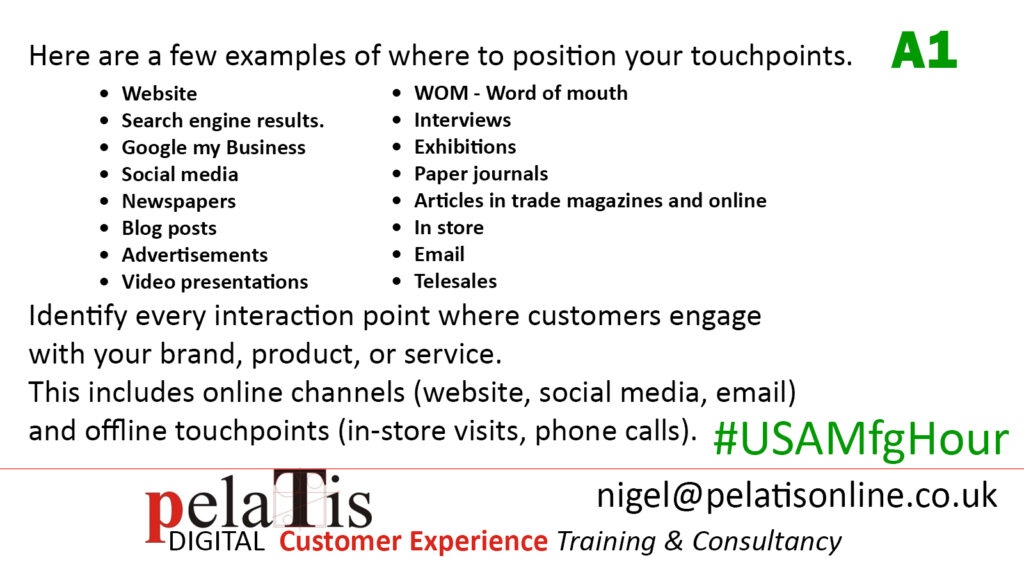
Host Packer provided a list of examples, including online and offline touchpoints. To close out this portion of the discussion, he asked participants whether they had considered all the potential touchpoints he included.
“That’s an awesome list, Nigel,” answered Kirsten Austin from DCSC, Inc..
In reply to Austin, host Packer added, “It is only part of the list… There are more, but I was restricted by the size of the display. Billboards large and small. Banners on bridges. A frame outside sites, etc…”
“Word of mouth is for sure important. I like that you included interviews – I had not considered that!” said Koch.
Responding to Koch, host Packer shared about his personal experience. “I have used all of these methods and many more. Anywhere that people gather/pass/hear/see has the potential to be a touchpoint, Whitney,” he said.
Common Pains During the Customer Journey
Participants were then asked to describe some of the pain points they have experienced when researching online or trying to purchase something. Host Packer clarified, explaining that “[p]ain points are moments of frustration, confusion, or dissatisfaction customers experience when researching or purchasing products and services.”
“I can’t stand it when I simply want to talk to someone and they either don’t list their number on the site or worse, they don’t answer the phone,” commented Austin.
Austin’s response prompted chat participants to respond.
“This is N° 3 on the all-time hates of web users,” said host Packer.
“That is incredibly frustrating!” commiserated Koch. “I hate calling and having to navigate confusing phone options. So many times I have been bounced around between departments – it’s hard to stay patient.”
Virtual assistance service provider VirtuDesk answered, “Most of the pain points we encountered were slow websites and difficult checkout processes. Lack of customer service options too. These things really make us frustrated.”
VirtuDesk’s response sparked a string of responses.
“N° 4 and N°5 of all-time hates for websites. When we have superfast broadband why are websites slow-loading? When it is easy to put information online, why don’t people want to sell their stuff?” mused host Packer.
“That’s true. They should put an effort into working their loading speeds,” added Stepanov.
“I agree with @virtudeskcom,” said Austin.
“Slow websites are particularly frustrating, as are sites that aren’t designed to be mobile-friendly!” exclaimed Koch.
“Oh, Scott and Jennifer [from Manufacturers’ News, Inc.] are always talking about being mobile-friendly. Good one,” McDermith replied to Koch.
“I agree with you. Not to mention not knowing you were charged twice already when you refreshed the page,” lamented Stepanov.
Amy Anderson provided a different perspective. “I find it frustrating when my full computer encounter is limited to mobile experience – especially when I get a paper bill that looks like a mobile print screen! Mobile is important, but it shouldn’t be the whole ball of wax – especially for B2B!” she said.
“Good point, Amy,” replied Koch. “It’s important for businesses to know how people interact with them (desktop/mobile) and make sure they’re not inadvertently alienating some customers.”
In response to host Packer’s original question, McDermith said: “I hate when pricing is hidden or I have to talk to someone to get pricing. (Do better #Saas #imtalkingtoyou).”
“N° 1 website hate of all time,” noted host Packer.
Koch added her own list of purchasing pain points. “Confusing website. Basic website with little information. Lack of or inactive social media channels. Long response time to inquiries,” she said.
Expounding on Koch’s answer, host Packer added: “Poor architecture and layout. Using designs that work for a butcher’s but not for a gallery. Fundamentally the web designers are not doing their jobs properly and the clients are not willing to pay the going rate.”
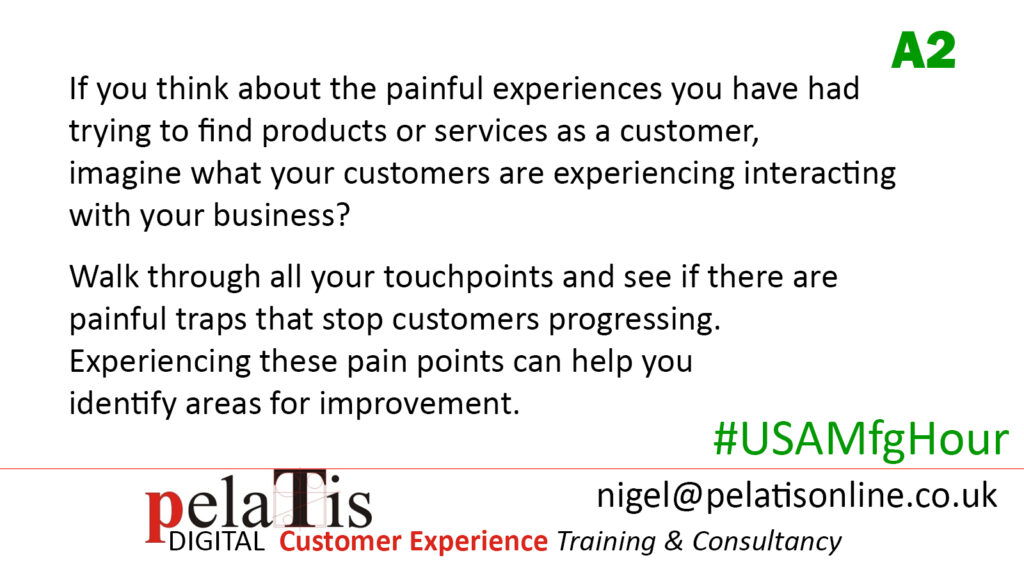
Concluding this portion of the discussion, host Packer offered this question for contemplation: “If you think about the painful experiences, you have had trying to find products or services as a customer, imagine what your customers are experiencing interacting with your business?”
Milestones of the Customer Journey
The chat then moved on to the steps of the customer journey. Host Packer asked participants to list the critical milestones of the buying process.
Austin was quick to venture a guess. “1.) Decide if they need something or determine they need something 2.) Start researching 3.) If it’s a bigger purchase talk to a few vendors 4.) Evaluate Price and Features 5.) Write the check or pull out the card!”
“Awareness, information gathering, consideration, action, and advocacy,” contributed Koch.
McDermith shared a longer list of milestones: “[A]wareness, interest, consideration, intent, evaluation, purchase, nurture, retain.”
“Awareness, consideration, decision, retention, and advocacy,” offered Stepanov.
Host Packer explained how he arrived at his list of customer journey milestones. “If we start with a customer who has never heard of you, or knows your company, its products and services exist, then you will get the following steps in the journey.”
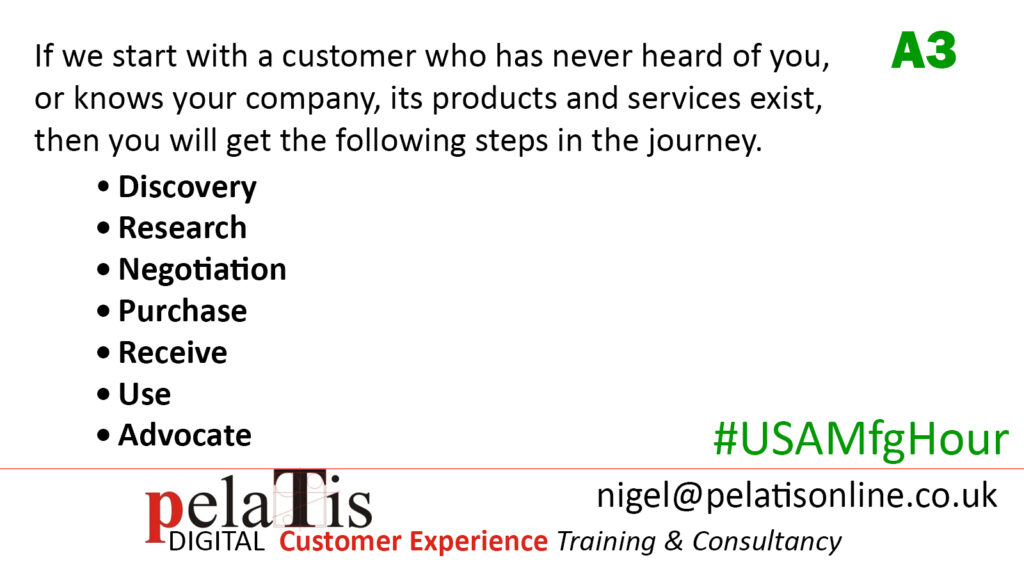
Host Packer’s milestones sparked a larger conversation about turning customers into advocates.
“I really like the final step you have listed,” proclaimed Anderson. “Advocate! A happy customer makes it easier to get the next customer and their experiences can inform improvement for your customer journey methodologies!”
“[O]nce the sale is completed, what can be done for the customer to make them an advocate?” host Packer reflected. “Most businesses drop the customer after they have paid. Turn them into advocates and they will do the lead generation for you.”
Anderson offered examples of what businesses can do to convert customers into brand advocates. “Simply doing regular check-ins to be sure everything is going as expected goes a long way to 1) demonstrate your investment in the customer. 2) provide a format for tweaking the product/user experience. 3) obtain feedback to improve future offerings.”
Austin agreed with Anderson. “I think it’s always nice to do something extra, like a thank you note or a little gift. Then always follow up, not obnoxiously but definitely asking for feedback.”
“The lifetime sales can build up handsomely with a bit of consideration,” host Packer pointed out.
Rick Gunnarson from Angi voiced his agreement with host Packer. “Amen, Nigel. Building relationships and EARNING trust and business is as crucial as the initial sale.”
How to Help Prospects Move Through the Customer Journey
With the milestones of the customer journey fresh in the chat participants’ minds, host Packer asked them to relate how they help their customers move along their buying journey.
“[O]nboarding emails, live demonstrations, newsletters, blogs and content, phone calls is all I can think of,” enumerated McDermith.
“Kati, if it is all online are the links going directly to the relevant page in the site?” host Packer questioned McDermith. “Some of the issues I have seen is the links don’t work, they take the customer to the home page of the website and the customer has to search the website for the page they want.”
Acknowledging host Packer’s question, McDermith responded, “[W]ell there’s always room for improvement, but I do try to be as specific as possible when using links – going directly to a specific page.”
“It’s important to provide content for each stage,” Koch pointed out. “At KSC, we have email newsletters, blogs, social media, regular meetings with clients, discovery calls, networking, webinars/podcast appearances, case studies…”
To affirm Koch’s answer, host Packer added: “Starting and keeping the conversation going by understanding the customer and helping them move to the next stage of their journey. Great answer.”
“From the awareness stage to consideration and purchasing, we usually do follow-ups, provide informative articles, discounts, and promos, ask for their feedback, and host live events for them,” described VirtuDeck.
Expounding on VirtuDesk’s response, host Packer said, “My…answer includes negotiation. This is not with the seller. This negotiation is with themselves or their company. How many of us as businesses think that the buyer needs to justify their purchase to themselves or the company they work for? How do we help them?”
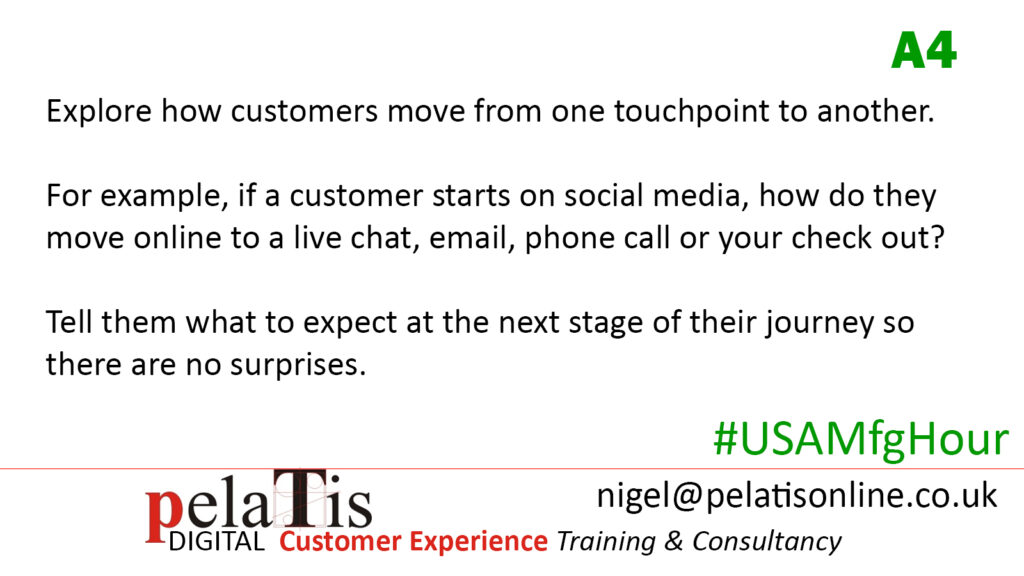
To close out the conversation, host Packer suggested exploring what actions or content move customers along the buying journey. He recommended clearly communicating with potential customers about what they can expect at each milestone.
Emotions and the Customer Journey: How Your Prospects Feel Throughout the Buying Process
Buying decisions are emotional, and because the customer buying journey has so many milestones or stages, customers experience a range of emotions throughout the process. To continue the discussion, host Packer asked participants to consider what emotions their customers feel as they move through the buying process.
“Frustration -> excitement -> caution -> accomplishment -> satisfaction,” offered Koch.
Amused by her answer, VirtuDesk commented, “Lol, frustration comes first!”
“[B]etter than at the end!” Koch emphasized.
Adding to Koch’s response, host Packer shared, “With all of the fraud that is going online they also fear losing their money. Fear it will break, is another.”
“Whoa this is hard,” Austin noted. “Curiosity (Is this even an emotion) [sic] Trepidation, Understanding, and then accomplishment?”
Host Packer encouraged Austin, stating: “Great guess. Think about your own experiences. What have you felt? Many have been the same.”
“Pain point/s – curiosity – optimism – excitement – satisfaction – relief,” commented VirtuDesk.
McDermith shared the emotions she hopes her customers feel. “[I]nterest, excitement, and hope…(at least I want that for them!)”
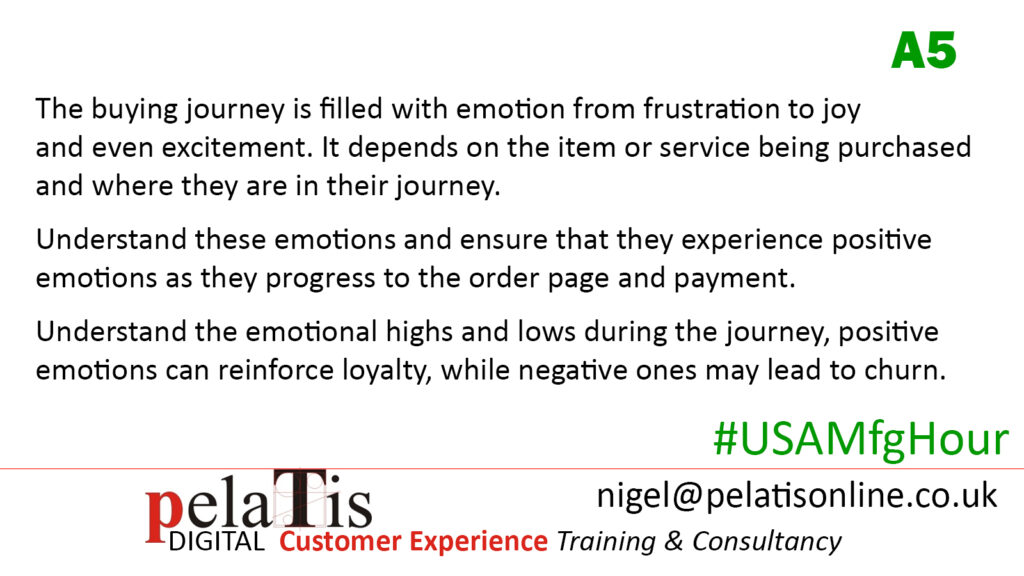
The customer journey can be an emotional rollercoaster, with customers experiencing frustration, excitement, and anything in between. Host Packer asserts that a customer’s emotions vary based on what is being purchased and which stage of the customer journey they are in.
The Players in the Customer Journey
The buying process is emotionally charged. For businesses to successfully move potential customers along the buying journey, those involved in the journey must understand that and do what they can to help prospects feel positive. But who actually is involved in the customer journey?
VirtuDesk broke their response out to align with the stages of the customer journey.
“Marketing (awareness and generating interest). Sales Reps (engaging and closing sales). CSR (Support/retention). UX/UI Designers,” they shared.
“Marketing, Sales, Customer Service, Shipping, Tech Support, but our data research team is the real MVP and our secret sauce,” McDermith asserted. “[W]hile they don’t have contact with the customer, without them, there is no customer.”
“Everyone,” declared Koch, to which host Packer responded, “Spot on we are all customer relationship managers.”
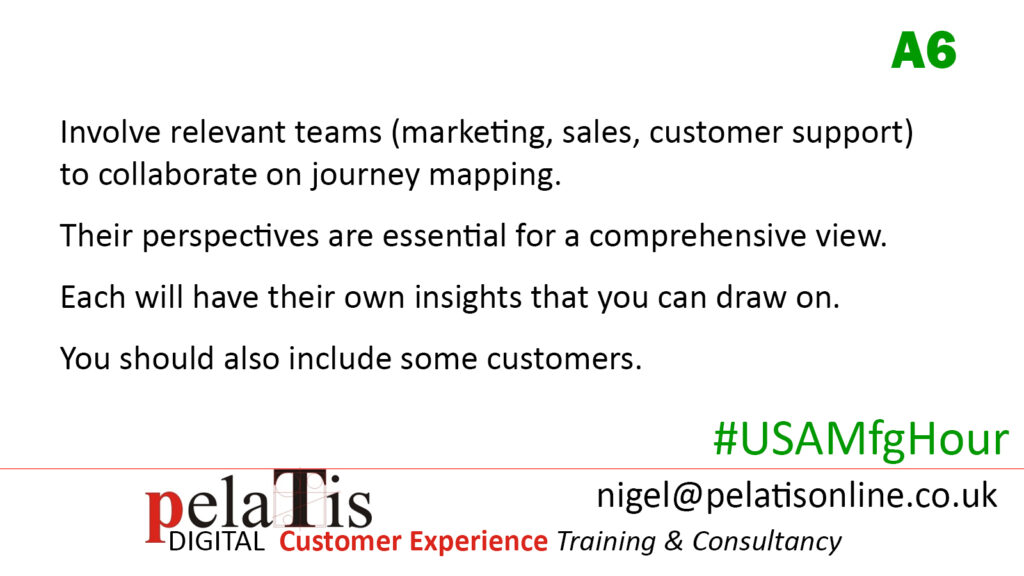
Host Packer advocated businesses take a collaborative approach when mapping their customers’ buying journey. For a holistic view of the customer experience, he suggested involving marketing, sales, and customer support teams and, ideally, existing customers.
Conclusion
By illuminating the multifaceted nature of the B2B customer journey during this #USAMfgHour chat, host Packer emphasized the importance of thorough mapping and strategic planning. When manufacturers take the time to identify customer touchpoints, address pain points, and understand the key milestones of the customer journey, they can enhance customer engagement and retention. Moreover, recognizing the emotional dynamics of the buying process and involving all stakeholders in the journey-mapping process can foster stronger customer relationships and drive long-term success.
About #USAMfgHour
Anyone who champions U.S. manufacturing can join in on a new conversation each week on X using the hashtag #USAMfgHour. The chat starts at 11 a.m. Pacific Standard Time/2 p.m. Eastern. Share positive blog posts, helpful articles, news, important information, accomplishments, events, and more with other manufacturers and supporters from throughout the country.
Are you interested in hosting a #USAMfgHour chat? Contact organizers @DCSCinc, @SocialSMktg, and @KeystoneClick.
To learn more about how Keystone Click can help you level up your online presence, contact us.